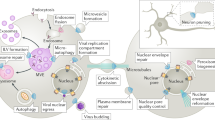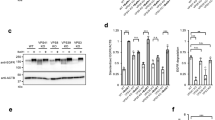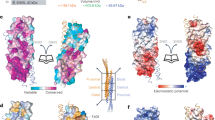Abstract
The endocytic network comprises a series of interconnected tubulo-vesicular membranous compartments that together regulate various sorting and signalling events. Although it is clear that defects in endocytic function underlie a variety of human diseases, our understanding of the molecular entities that regulate these sorting and signalling events remains limited. Here we discuss the sorting nexins family of proteins and propose that they have a fundamental role in orchestrating the formation of protein complexes that are involved in endosomal sorting and signalling.
This is a preview of subscription content, access via your institution
Access options
Subscribe to this journal
Receive 12 print issues and online access
$189.00 per year
only $15.75 per issue
Buy this article
- Purchase on Springer Link
- Instant access to full article PDF
Prices may be subject to local taxes which are calculated during checkout




Similar content being viewed by others
References
Teasdale, R. D., Loci, D., Houghton, F., Karlsson, L. & Gleeson, P. A. A large family of endosome-localized proteins related to sorting nexin 1. Biochem. J. 358, 7–16 (2001).
Carlton, J. G., Bujny, M. V., Rutherford, A. & Cullen, P. J. Sorting nexins – unifying trends and new perspectives. Traffic 6, 75–82 (2005).
Seet, L. F. & Hong, W. The Phox (PX) domain proteins and membrane traffic. Biochim. Biophys. Acta 1761, 878–896 (2006).
Rogaeva, E. et al. The neuronal sortilin-related receptor SORL1 is genetically associated with Alzheimer disease. Nature Genet. 39, 168–177 (2007).
Alto, N. M. et al. The type III effector EspF coordinates membrane trafficking by the spatiotemporal activation of two eukaryotic signaling pathways. J. Cell Biol. 178, 1265–1278 (2007).
Bonifacino, J. S. & Rojas, R. Retrograde transport from endosomes to the trans-Golgi network. Nature Rev. Mol. Cell Biol. 7, 568–579 (2006).
Soldati, T. & Schliwa, M. Powering membrane traffic in endocytosis and recycling. Nature Rev. Mol. Cell Biol. 7, 897–908 (2006).
Carlton, J. G. et al. Sorting nexin-1 mediates tubular endosome-to-TGN transport through co-incidence sensing of high curvature membranes and 3-phosphoinositides. Curr. Biol. 14, 1791–1800 (2004).
McMahon, H. T & Gallop, J. L. Membrane curvature and mechanisms of dynamic cell membrane remodelling. Nature 438, 590–596 (2005).
Carlton, J. G. & Cullen, P. J. Co-incidence detection in phosphoinositide signalling. Trends Cell Biol. 15, 540–547 (2005).
Yarar, D., Waterman-Storer, C. M. & Schmid, S. L. SNX9 couples actin assembly to phosphoinositide signals and is required for membrane remodeling during endocytosis. Dev. Cell 13, 43–56 (2007).
Traer, C. J. et al. Sorting nexin-4 co-ordinates endosomal sorting of transferrin receptor with dynein-mediated transport into the endocytic recycling compartment. Nature Cell Biol. 9, 1370–1380 (2007).
Yarar, D., Surka, M. C., Leonard, M. C. & Schmid, S. L. SNX9 activities are regulated by multiple phosphoinositides through both PX and BAR domains. Traffic 9, 133–146 (2008).
Shimada, A. et al. Curved EFC/F-BAR-domain dimers are joined end to end into a filament for membrane invagination in endocytosis. Cell 129, 761–772 (2007).
Frost, A. et al. Structural basis of membrane invagination by F-BAR domains. Cell 132, 807–817 (2008).
Pylypenko, O., Lundmark, R., Rasmuson, E., Carlsson, S. R. & Rak, A. The PX-BAR membrane-remodeling unit of sorting nexin 9. EMBO J. 26, 4788–4800 (2007).
Mari, M. et al. Sortilin and mannose 6-phosphate receptors define an exit from early endosomal vacuoles for SNX1-dependent recycling to the TGN. Traffic 9, 380–393 (2008).
Seaman, M. N. Recycle your receptors with retromer. Trends Cell Biol. 15, 68–75 (2005).
Bonifacino, J. S. & Hurley, J. H. Retromer. Curr. Opin. Cell Biol. 9 May 2008 (doi: 10.1016/j.ceb.2008.03.009).
Hierro, A. et al. Functional architecture of the retromer cargo-recognition complex. Nature 449, 1063–1067 (2007).
Vergés, M. et al. The mammalian retromer regulates transcytosis of the polymeric immunoglobulin receptor. Nature Cell Biol. 6, 763–769 (2004).
Coudreuse, D. Y., Roel, G., Betist, M. C., Destree, O. & Korswagen, H. C. Wnt gradient formation requires retromer function in Wnt-producing cells. Science 312, 921–924 (2006).
Prasad, B. C. & Clark, S. G. Wnt signaling establishes anteroposterior neuronal polarity and requires retromer in C. elegans. Development 133, 1757–1766 (2006).
Belenkaya, T. Y. et al. The retromer complex influences Wnt secretion by recycling Wntless from endosomes to the trans-Golgi network. Dev. Cell 14, 120–131 (2008).
Pan, C.-L. et al. C. elegans AP-2 and retromer control Wnt signaling by regulating MIG-14/Wntless. Dev. Cell 14, 132–139 (2008).
Yang, P.-T. et al. Wnt signaling requires retromer-dependent recycling of MIG-14/Wntless in Wnt-producing cells. Dev. Cell 14, 140–147 (2008).
Franch-Marro, X. et al. Wingless secretion requires endosome-to-Golgi retrieval of Wntless/Evi/Sprinter by the retromer complex. Nature Cell Biol. 10, 170–177 (2008).
Port, F. et al. Wingless secretion promotes and requires retromer-dependent cycling of Wntless. Nature Cell Biol. 10, 178–185 (2008).
Jaillais, Y. Fobis-Loisy, I., Miège, C., Rollin, C. & Gaude, T. AtSNX1 defines an endosome for auxin-carrier trafficking in Arabidopsis. Nature 443, 106–109 (2006).
Jaillais, Y. The retromer protein VPS29 links cell polarity and organ initiation in plants. Cell 130, 1057–1070 (2007).
Hausmann, G., Banziger, C. & Basler, K. Helping Wingless take flight: how WNT proteins are secreted. Nature Rev. Mol. Cell Biol. 8, 331–336 (2007).
Korolchuk, V. I. et al. Drosophila Vps35 function is necessary for normal endocytic trafficking and actin cytoskeleton organisation. J. Cell Sci. 120, 4367–4376 (2007).
Bujny, M. V., Poppoff, V., Johannes, L. & Cullen, P. J. The retromer component, sorting nexin-1, is required for efficient retrograde transport of Shiga toxin from early endosome to the trans-Golgi network. J. Cell Sci. 120, 2010–2021 (2007).
Popoff, V. et al. The retromer complex and clathrin define an early endosomal retrograde exit site. J. Cell Sci. 120, 2022–2031 (2007).
Utskarpen, A., Slagsvold, H. H., Dyve, A. B., Skånland, S. S. & Sandvig, K. SNX1 and SNX2 mediate retrograde transport of Shiga toxin. Biochem. Biophys. Res. Commun. 358, 566–570 (2007).
Skånland, S. S., Wälchli, S., Utskarpen, A., Wandinger-Ness, A. & Sandvig, K. Phosphoinositide-regulated retrograde transport of ricin: crosstalk between hVps34 and sorting nexins. Traffic 8, 297–309 (2007).
Nielsen, M. S. et al. Sorting by the cytoplasmic domain of the amyloid precursor protein binding receptor SorLA. Mol. Cell. Biol. 27, 6842–6851 (2007).
Small, S. A. et al. Model-guided microarray implicates the retromer complex in Alzheimer's disease. Ann. Neurol. 58, 909–919 (2005).
He, X., Li, F., Chang, W. P. & Tang, J. GGA proteins mediate the recycling pathway of memapsin 2 (BACE). J. Biol. Chem. 280, 11696–11703 (2005).
Griffin, C. T., Trejo, J. & Magnuson, T. Genetic evidence for a mammalian retromer complex containing sorting nexins 1 and 2. Proc. Natl Acad. Sci. USA 102, 15173–15177 (2005).
Carlton, J. G. et al. Sorting nexin-2 is associated with tubular elements of the early endosome, but is not essential for retromer-mediated endosome-to-TGN transport. J. Cell Sci. 118, 4527–4539 (2005).
Rojas, R., Kametaka, S., Haft, C. R. & Bonifacino, J. S. Interchangeable but essential functions of SNX1 and SNX2 in the association of retromer with endosomes and the trafficking of mannose 6-phosphate receptors. Mol. Cell. Biol. 27, 1112–1124 (2007).
Wassmer, T. et al. A loss-of-function screen reveals sorting nexin-5 and sorting nexin-6 as potential components of the mammalian retromer. J. Cell Sci. 120, 45–54 (2007).
Liu, H. et al. Inhibitory regulation of EGF receptor degradation by sorting nexin 5. Biochem. Biophys. Res. Commun. 342, 537–546 (2006).
Seaman, M. N. Identification of a novel conserved sorting motif required for retromer-mediated endosome-to-TGN retrieval. J. Cell Sci. 120, 2378–2389 (2007).
Gokool, S., Tattersall, D. & Seaman, M. N. EHD1 interacts with retromer to stabilize SNX1 tubules and facilitate endosome-to-Golgi retrieval. Traffic 8, 1873–1886 (2007).
Ganley, I. G., Espinosa, E. & Pfeffer, S. R. A syntaxin 10-SNARE complex distinguishes two distinct transport routes from endosomes to the trans-Golgi in human cells. J. Cell Biol. 283, 159–172 (2008).
Strochlic, T. I., Setty, T. G., Sitaram, A. & Burd, C. G. Grd19/Snx3p functions as a cargo-specific adapter for retromer-dependent endocytic recycling. J. Cell Biol. 177, 115–125 (2007).
Pelham, H. R. Insights from yeast endosomes. Curr. Opin. Cell Biol. 14, 454–462 (2002).
Lundmark, R. & Carlsson, S. R. Regulated membrane recruitment of dynamin-2 mediated by sorting nexin 9. J. Biol. Chem. 279, 42694–42702 (2004).
Soulet, F., Yarar, D., Leonard, M. & Schmid, S. L. SNX9 regulates dynamin assembly and is required for efficient clathrin-mediated endocytosis. Mol. Biol. Cell 16, 2058–2067 (2005).
Badour, K. et al. Interaction of the Wiskott-Aldrich syndrome protein with sorting nexin 9 is required for CD28 endocytosis and cosignaling in T cells. Proc. Natl Acad. Sci. USA 104, 1593–1598 (2007).
Håberg, K., Lundmark, R. & Carlsson, S. R. SNX18 is an SNX9 paralog that acts as a membrane tubulator in AP-1-positive endosomal trafficking. J. Cell Sci. 121, 1495–1505 (2008).
Hettema, E. H., Lewis, M. J., Black, M. W. & Pelham, H. R. Retromer and the sorting nexins Snx4/41/42 mediate distinct retrieval pathways from yeast endosomes. EMBO J. 22, 548–557 (2003).
Maxfield, F. R. & McGraw, T. E. Endocytic recycling. Nature Rev. Mol. Cell Biol. 5, 121–132 (2004).
Hoepfner, S. et al. Modulation of receptor recycling and degradation by the endosomal kinesin KIF16B. Cell 121, 437–450 (2005).
Zheng, B. et al. Essential role of RGS-PX1/sorting nexin 13 in mouse development and regulation of endocytosis dynamics. Proc. Natl Acad. Sci. USA 103, 16776–16781 (2006).
Zheng, B. et al. RGS-PX1, a GAP for Gαs and sorting nexin in vesicular trafficking. Science 294, 1939–1942 (2001).
Zheng, B. et al. Regulation of epidermal growth factor receptor degradation by heterotrimeric Gαs protein. Mol. Biol. Cell 15, 5538–5550 (2004).
Lunn, M. L. et al. A unique sorting nexin regulates trafficking of potassium channels via a PDZ domain interaction. Nature Neurosci. 10, 1249–1259 (2007).
Rincón, E. et al. Proteomics identification of sorting nexin 27 as a diacylglycerol kinase ζ-associated protein: new diacylglycerol kinase roles in endocytic recycling. Mol. Cell. Proteomics 6, 1073–1087 (2007).
MacNeil, A. J., Mansour, M. & Pohajdak, B. Sorting nexin 27 interacts with the cytohesin associated scaffolding protein (CASP) in lymphocytes. Biochem. Biophys. Res. Commun. 359, 848–853 (2007).
Williams, R. L. & Urbé, S. The emerging shape of the ESCRT machinery. Nature Rev. Mol. Cell Biol. 8, 355–368 (2007).
Kärkkäinen, S. et al. Identification of preferred protein interactions by phage-display of the human Src homology-3 proteome. EMBO Rep. 7, 186–191 (2006).
Qin, B., He, M., Chen, X. & Pei, D. Sorting nexin 10 induces giant vacuoles in mammalian cells. J. Biol. Chem. 281, 36891–26896 (2006).
Schaff, U. Y. et al. SLIC-1/sorting nexin 20: A novel sorting nexin that directs subcellular distribution of PSGL-1. Eur. J. Immunol. 38, 550–564 (2008).
Lee, J. et al. Adaptor protein sorting nexin 17 regulates amyloid precursor protein trafficking and processing in the early endosomes. J. Biol. Chem. 283, 11501–11508 (2008).
van Kerkhof, P. et al. Sorting nexin 17 facilitates LRP recycling in the early endosome. EMBO J. 24, 2851–2861 (2005).
Shin, N. et al. SNX9 regulates tubular invagination of the plasma membrane through interaction with actin cytoskeleton and dynamin 2. J. Cell Sci. 121, 1252–1263 (2008).
Rutherford, A. C. et al. The mammalian phosphatidylinositol 3 monophosphate 5-kinase PIKfyve regulates endosome-to-TGN retrograde transport. J. Cell Sci. 119, 3944–3957 (2006).
Zhang, Y. et al. Loss of Vac14, a regulator of the signaling lipid phosphatidylinositol 3, 5-bisphosphate, results in neurodegeneration in mice. Proc. Natl Acad. Sci. USA 104, 17518–17523 (2007).
Dove, S. K. et al. Svp1p defines a family of phosphatidylinositol 3,5-bisphosphate effectors. EMBO J. 23, 1922–1933 (2004).
Jeffries, T. R., Dove, S. K., Michell, R. H. & Parker, P. J. PtdIns-specific MPR pathway association of a novel WD40 repeat protein, WIPI49. Mol. Biol. Cell 15, 2652–2663 (2004).
Kerr, M. C. et al. A novel mammalian retromer component, Vps26B. Traffic 6, 991–1001 (2005).
Shi, H., Rojas, R., Bonifacino, J. S. & Hurley, J. H. The retromer subunit Vps26 has an arrestin fold and binds Vps35 through its C-terminal domain. Nature Struct. Mol. Biol. 13, 540–548 (2006).
Collins, B. M. et al. Structure of Vps26B and mapping of its interaction with the retromer protein complex. Traffic 9, 366–379 (2008).
Wang, D. et al. Crystal structure of human Vps29 reveals a phosphodiesterase/nuclease-like fold and two protein–protein interaction sites. J. Biol. Chem. 280, 22962–22967 (2005).
Collins, B. M., Skinner, C. F., Watson, P. J., Seaman, M. N. & Owen, D. J. Vps29 has a phosphoesterase fold that acts as a protein interaction scaffold for retromer assembly. Nature Struct. Mol. Biol. 12, 594–602 (2005).
Gokool, S., Tattersall, D., Reddy, J. V. & Seaman, M. N. Identification of a conserved motif required for Vps35p/Vps26p interaction and assembly of the retromer complex. Biochem. J. 408, 287–295 (2007).
Restrepo, R. et al. Structural features of vps35p involved in interaction with other subunits of the retromer complex. Traffic 8, 1841–1853 (2007).
Zhao, X. et al. Dominant-negative behaviour of mammalian Vps35 in yeast requires a conserved PRLYL motif involved in retromer assembly. Traffic 8, 1829–1840 (2007).
Haft, C. R. et al. Human orthologs of yeast vacuolar protein sorting proteins Vps26, 29, and 35: assembly into multimeric complexes. Mol. Biol. Cell 11, 4105–4116 (2000).
Mayor, S. & Pagano, R. E. Pathways of clathrin-independent endocytosis. Nature Rev. Mol. Cell Biol. 8, 603–612 (2007).
Acknowledgements
I apologize to those colleagues for whom a lack of space has precluded discussion of their work. I am grateful to J. Carlton and my laboratory colleagues N. Attar, C. Danson, J. Oakley, C. Traer and T. Wassmer for their critical reading of the manuscript and their suggestions. I am indebted to C. Traer for help in preparing Figure 1. Work in our laboratory is supported by The Wellcome Trust.
Author information
Authors and Affiliations
Related links
Related links
DATABASES
Interpro
OMIM
FURTHER INFORMATION
Rights and permissions
About this article
Cite this article
Cullen, P. Endosomal sorting and signalling: an emerging role for sorting nexins. Nat Rev Mol Cell Biol 9, 574–582 (2008). https://doi.org/10.1038/nrm2427
Published:
Issue Date:
DOI: https://doi.org/10.1038/nrm2427
This article is cited by
-
Partial loss of Sorting Nexin 27 resembles age- and Down syndrome-associated T cell dysfunctions
Immunity & Ageing (2024)
-
SNX17 Mediates Dendritic Spine Maturation via p140Cap
Molecular Neurobiology (2024)
-
Comprehensive analysis and validation of SNX7 as a novel biomarker for the diagnosis, prognosis, and prediction of chemotherapy and immunotherapy response in hepatocellular carcinoma
BMC Cancer (2023)
-
Identifying novel regulatory effects for clinically relevant genes through the study of the Greek population
BMC Genomics (2023)
-
Endosomal sorting results in a selective separation of the protein corona from nanoparticles
Nature Communications (2023)



